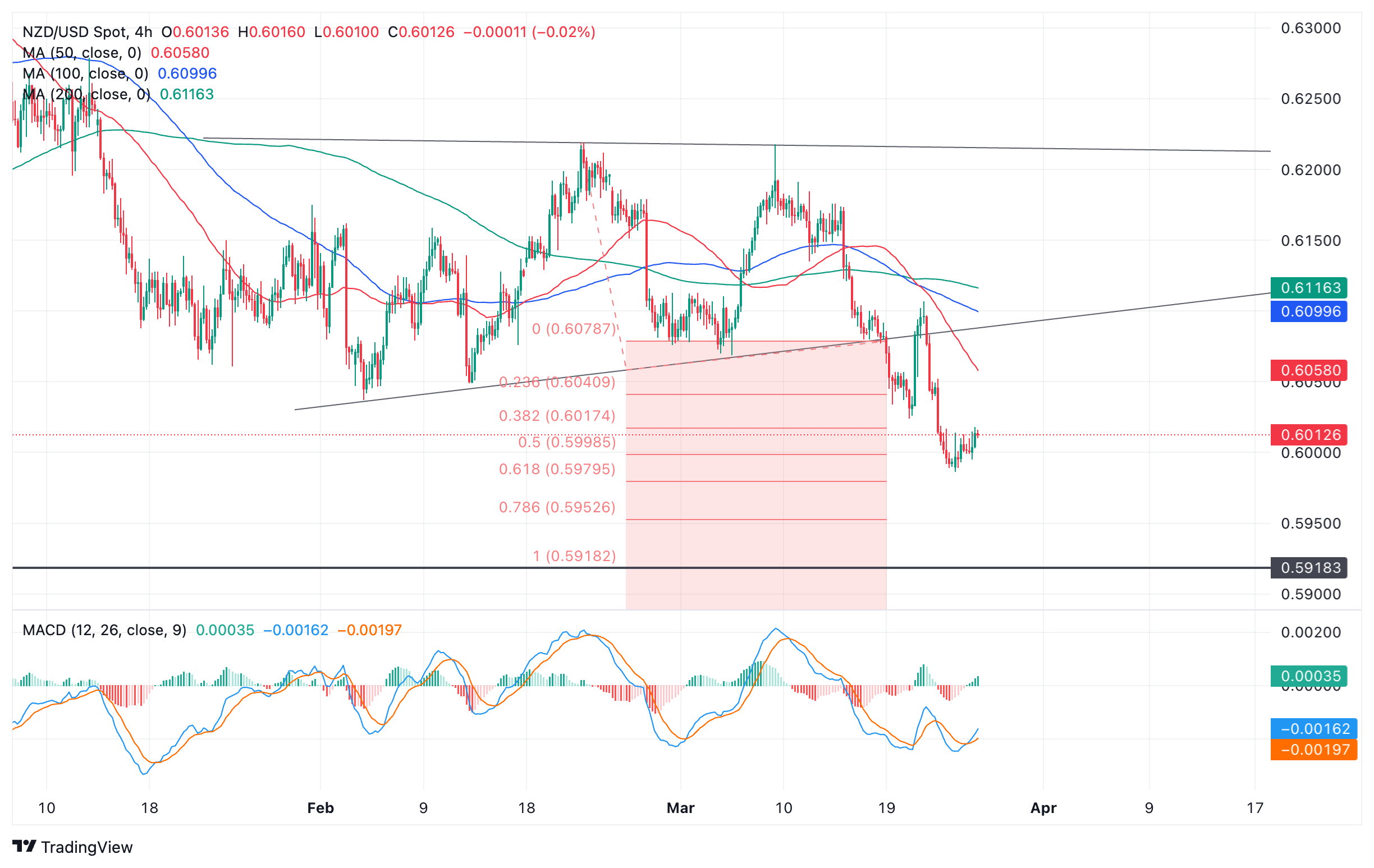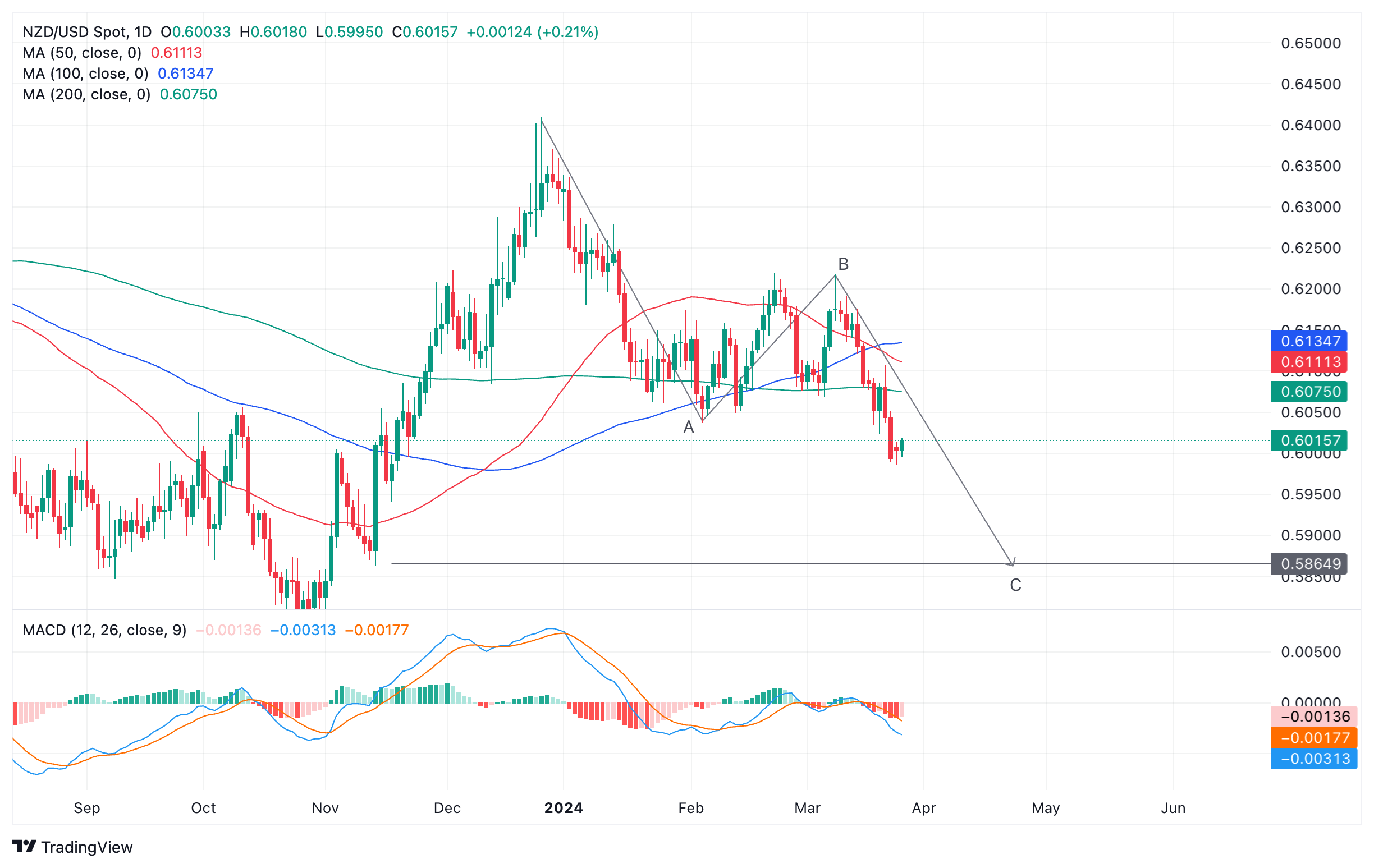New Zealand Dollar recovers on positive risk tone

- The New Zealand Dollar rises on positive risk appetite.
- Risky assets rise on hopes of central banks cutting interest rates.
- The RBNZ has not committed to cutting rates, however, as inflation remains high despite slow growth.
The New Zealand Dollar (NZD) is trading higher in its most traded pairs on Tuesday as markets adopt a positive risk tone, benefiting commodity currencies like the New Zealand Dollar over safe havens.
European Stocks are mostly higher on hopes it will not be long before the European Central Bank (ECB) cuts interest rates, thereby cheapening credit.
The German DAX, British FTSE 100, Italian IT40 and Spanish IBEX are all showing gains, with only the French CAC40 down, after data showed a wider-than-expected 5.5% French government budget deficit in 2023, according to data from the statistics office INSEE.
New Zealand Dollar suffers from negative fundamentals
Despite this recent uptick, the New Zealand Dollar is under pressure from bearish fundamentals.
Recent data showed the New Zealand economy fell into a technical recession in the fourth quarter of 2024, whilst headline inflation remained relatively high at 4.7% during the same reporting period, even if it fell from the 5.6% recorded in Q3.
Despite weak growth, the Reserve Bank of New Zealand (RBNZ) does not envision itself cutting interest rates due to high inflation. Elevated price growth is partly a result of structural issues such as a tight labor market, which in turn keeps wage inflation high.
In a speech about monetary policy at a Chartered Accountants’ event on Tuesday, RBNZ Chief Economist Paul Conway reiterated the bank’s core message that interest rates would have to remain high for some time yet in order to bring down inflation.
“Interest rates need to remain at a restrictive level for a sustained period of time to meet our inflation objective,” said the notes from the speech, repeating the RBNZ’s official line.
Technical Analysis: New Zealand Dollar pulls back in downtrend
NZD/USD – the number of US Dollars one New Zealand Dollar can buy – continues pulling back within a short-term downtrend.
The pair recently broke out of a Wedge pattern and is forecast to continue falling until it reaches the conservative target for the pattern.
New Zealand Dollar versus US Dollar: 4-hour chart
According to technical analysis theory, the target lies at a distance equivalent to the height of the wedge extrapolated lower. In the case of NZD/USD it suggests more downside to a conservative target at 0.5964, the 0.618 Fibonacci ratio of the height of the pattern extrapolated from the breakout point lower. The full ratio (1.000) provides a further target at 0.5892.
New Zealand Dollar versus US Dollar: Daily chart
Adding to the bearish outlook is the possible formation of an ABC pattern or Measured Move on the daily chart.
If so, NZD/USD could be unfolding in the final wave C of the pattern, which could stretch to a long-term target at 0.5864, where wave C is equal to wave A.
Only a break above the 0.6107 March 21 high would bring into doubt the bearish bias.
RBNZ FAQs
The Reserve Bank of New Zealand (RBNZ) is the country’s central bank. Its economic objectives are achieving and maintaining price stability – achieved when inflation, measured by the Consumer Price Index (CPI), falls within the band of between 1% and 3% – and supporting maximum sustainable employment.
The Reserve Bank of New Zealand’s (RBNZ) Monetary Policy Committee (MPC) decides the appropriate level of the Official Cash Rate (OCR) according to its objectives. When inflation is above target, the bank will attempt to tame it by raising its key OCR, making it more expensive for households and businesses to borrow money and thus cooling the economy. Higher interest rates are generally positive for the New Zealand Dollar (NZD) as they lead to higher yields, making the country a more attractive place for investors. On the contrary, lower interest rates tend to weaken NZD.
Employment is important for the Reserve Bank of New Zealand (RBNZ) because a tight labor market can fuel inflation. The RBNZ’s goal of “maximum sustainable employment” is defined as the highest use of labor resources that can be sustained over time without creating an acceleration in inflation. “When employment is at its maximum sustainable level, there will be low and stable inflation. However, if employment is above the maximum sustainable level for too long, it will eventually cause prices to rise more and more quickly, requiring the MPC to raise interest rates to keep inflation under control,” the bank says.
In extreme situations, the Reserve Bank of New Zealand (RBNZ) can enact a monetary policy tool called Quantitative Easing. QE is the process by which the RBNZ prints local currency and uses it to buy assets – usually government or corporate bonds – from banks and other financial institutions with the aim to increase the domestic money supply and spur economic activity. QE usually results in a weaker New Zealand Dollar (NZD). QE is a last resort when simply lowering interest rates is unlikely to achieve the objectives of the central bank. The RBNZ used it during the Covid-19 pandemic.

